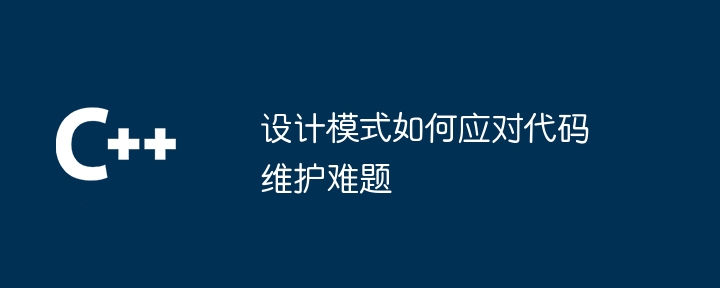Home >Backend Development >C++ >How design patterns deal with code maintenance challenges
How design patterns deal with code maintenance challenges
- WBOYWBOYWBOYWBOYWBOYWBOYWBOYWBOYWBOYWBOYWBOYWBOYWBOriginal
- 2024-05-09 12:45:01808browse
Design patterns solve code maintenance challenges by providing reusable and extensible solutions: Observer pattern: allows objects to subscribe to events and receive notifications when events occur. Factory Pattern: Provides a centralized way to create objects without relying on concrete classes. Singleton pattern: ensures that a class has only one instance, which is used to create globally accessible objects.

How design patterns deal with code maintenance challenges
Code maintenance is a difficult task, especially for large projects. Design patterns can help solve this problem by providing reusable and scalable solutions.
Observer Pattern
The Observer pattern allows objects to subscribe to events and receive notifications when events occur. This avoids hard-coded dependencies, making your code more readable and maintainable.
public class Subject {
private List<Observer> observers = new ArrayList<>();
public void addObserver(Observer observer) {
observers.add(observer);
}
public void removeObserver(Observer observer) {
observers.remove(observer);
}
public void notifyObservers() {
for (Observer observer : observers) {
observer.update();
}
}
}
public class Observer {
public void update() {
// Implement logic to respond to event
}
}Practical case: In GUI applications, controller objects can act as Subjects, and buttons, text boxes, and labels can act as Observers. When the user interacts with the control, the controller notifies all Observers to make corresponding updates.
Factory Pattern
The factory pattern provides a centralized way to create objects without relying on concrete classes. This eliminates hard-coded dependencies on class hierarchies, making the code easier to modify and extend.
public interface Shape {
void draw();
}
public class Circle implements Shape {
@Override
public void draw() {
// Draw circle
}
}
public class Square implements Shape {
@Override
public void draw() {
// Draw square
}
}
public class ShapeFactory {
public static Shape getShape(String shapeType) {
switch (shapeType) {
case "CIRCLE":
return new Circle();
case "SQUARE":
return new Square();
default:
throw new IllegalArgumentException("Invalid shape type");
}
}
}Practical case: In the graphics editor, ShapeFactory can create specific shape objects based on user selections. This eliminates the need to directly instantiate different shape classes.
Singleton pattern
The singleton pattern ensures that there is only one instance of a class. This is useful for creating globally accessible objects, such as logging objects or database connection objects.
public class Singleton {
private static Singleton instance;
private Singleton() {}
public static Singleton getInstance() {
if (instance == null) {
instance = new Singleton();
}
return instance;
}
}Practical case: In server applications, the singleton pattern can be used to create unique data access objects to ensure data consistency.
The above is the detailed content of How design patterns deal with code maintenance challenges. For more information, please follow other related articles on the PHP Chinese website!
Related articles
See more- Graphical introduction to JavaScript data access performance optimization plan
- What are the six principles of design patterns?
- Share PHP design pattern learning summary
- How to use Python regular expressions for code maintenance and optimization
- What is the impact of Golang generics on function libraries and code maintenance?

